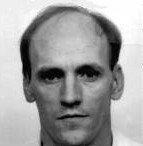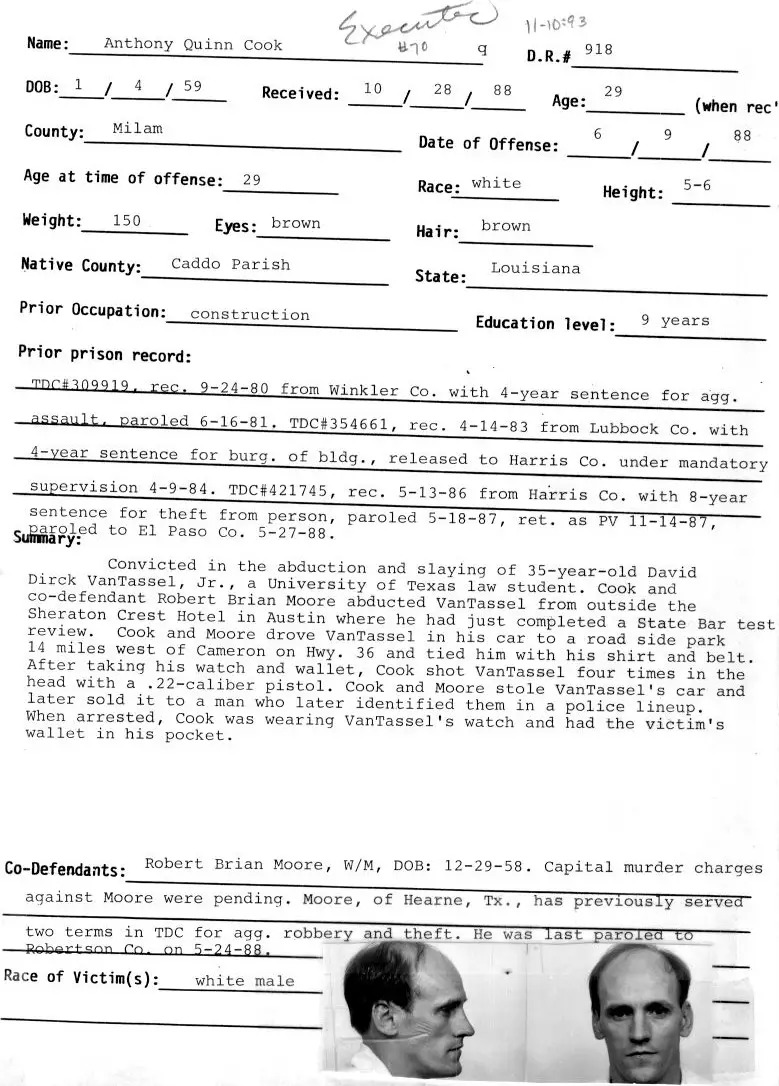A Day in the Death of Inmate no. 918
November 14, 2003
HUNTSVILLE - Execution of Inmate No. 918 was
nothing if not efficient. At the stroke of midnight Tuesday, the
inmate took the last steps of his life on Earth from a holding cell
into the death chamber.
By 12:01 a.m. Wednesday, five thick tan straps
secured his legs, waist, and torso to a stainless steel gurney with
a cushion on top.
His arms were stretched wide. Intervenes tubes
were quickly inserted into each.
His head lay flat. His eyes blinked rapidly. He
stared into the microphone, suspended two feet above his mouth.
Above the microphone, was a bright fluorescent light.
At 12:03, a harmless saline solution began
flowing into his left arm and, at 12:05, into his right.
Witnesses quickly were ushered into the adjoining
room with drab brown carpet and white curtains around the walls. A
glass partition and bars separated the witnesses from inmate No.
918.
The instant the last witness was in the room, a
figure appeared from a room behind the death chamber. The figure
nodded to Warden Morris Jones, standing by the gurney. It was 12:08.
"We're ready warden," he said.
Two minutes alter, Anthony Cook, who said he had
turned his soul over to Jesus Christ, forfeited his life to the
State of Texas. In that regard, his case is not unique. Texas has
executed 70 men since 1982, more than any other state.
But Cook's case was unusual in two ways. Unlike
most condemned prisoners, he submitted to his fate by choosing not
to appeal his death sentence. And, for the first time since the
state resumed execution 11 years ago, it executed a killer whose
victim lived in Travis County.
Texas the Leader
For years, the Supreme Court has been whittling
away at efforts by capital punishment opponents to get death
sentences overturned. And for years, opponents have warned that what
had been a trickle of executions was about to become a torrent.
Cook's execution which took a total of 15 minutes
start to finish, shows how routine they have become in Texas. Indeed,
seven more executions have been scheduled over the next 31 days,
although almost all of these are likely to be stayed. Across the
nation, 38 people have been executed this year and 17 in Texas.
The first women likely to be executed by the
State of Texas -Karla Faye Tucker- had been scheduled to die early
Friday. But she received a stay last week.
Proponents of capital punishment shed no tears
for the inmates, pointing out that their executions are painless
compared with the often brutal agony their victims faced before they
died. Opponents, however, still cringe at the loss of one human's
life, no matter the circumstances.
Consent to Die
Cook's execution went quickly, even by Huntsville
standards. Indeed, his case was unusual because there was no appeal
pending, no waiting for the phone call that might signal the 11th
hour reprieve. Prison officials were ready to proceed when the clock
struck midnight, as called for in the death warrant.
Cook was sentenced to lethal injection for the
1988 murder of David Dirck Van Tassel Jr., a University of Texas law
school graduate who was abducted from the parking lot of a downtown
hotel and driven to Milam County, where he was shot four times and
robbed of his car, wallet and watch.
At first, Cook proclaimed his innocence in the
crime, which was prosecuted in Milam County. But then he found Jesus.
Though he did not relish the thought of execution, he decided that
the Bible decreed he should die for his crime. He waived all his
appeals, except the one required by state law. Lawyers could do
nothing.
Condemned inmates spend an average of 8.4 years
on death row before execution. Cook spent five years there. He was
what death penalty opponents call "a consensual." Prison officials
could not remember a similar case since James Smith consented to
execution on June 6, 1990.
Outside the Walls Unit, Dennis Longmire stood
with one other death penalty opponent shortly before midnight. A
rolling mist chilled the university professor?s bones. What was
about to happen inside chilled his soul.
"This is an odd one to be at since the guy is
volunteering for it," said the Sam Houston State University
criminology professor. "The more (executions) we do, the easier it
becomes, I believe. It greatly concerns me."
Barbara Stetzelberger, the slain victim's widow,
waited in Austin for a phone call informing her that her husband's
killer was dead.
"I don?t have any wish for his death,"
Stezelberger said. "I feel that's a decision we've made as a society.
I think God is the only one who knows justice.
"I have a good life, but it's never the same,"
she added. "You go on and rebuild, but it's not the same. It gives
you a good idea of what people in wars go through. I think our wars
are on the streets."
"Mood Appears Calm"
Van Tassel's murder was sudden and brutal. Cook's
execution, like all others, was well planned. His last 24 hours were
documented meticulously.
By the time execution day arrives, condemned
inmates have drawn up their last will and testament. They have
specified what will be done with their bodies. They have decided
what they want, if anything, for their final meal.
Prison employees monitor condemned inmates
constantly during the final 24 hours. In 1974, the state, responding
to a U.S. Supreme Court verdict, rewrote its death penalty statues.
The very first inmate sent to death row under the new laws cheated
the executioner by killing himself on July 1 of that year.
The Cook vigil began at midnight Monday.
"Lying on bunk," read the guard's log.
At 1:15a.m., he sat up and wrote a letter. Ninety
minutes later, he sipped coffee and chatted with a guard named
O'Ginn.
Three a.m. brought an early breakfast: pancakes,
syrup, oatmeal, gravy, butter, sugar, milk and coffee. He followed
the meal with a nap. For the final 24 hours, when it comes to eating
and sleeping, normalcy is suspended.
At 8:20 a.m., Cook began saying goodbye to his
family. The visits continued on and off throughout the day, until 4
p.m. Then it was time to say goodbye to "The Row."
Condemned prisoners are moved to the Walls Unit
the day before the execution. Death row is located in the Ellis Unit,
16 miles north of Huntsville. For security reasons inmates are moved
at various times, and different routes are used. Only a few people
know the time and the route for each trip to the holding cell next
to the death chamber. Cook was picked up at 4 p.m. He was ushered
into a holding cell next to the death chamber at 4:30 p.m.
"Mood appears to be calm," the guard noted in his
log.
The Last Meal
The best-known ritual of capital punishment is
the last meal.
Most of the 70 inmates who have been executed in
Texas since 1982 requested traditional fare such as T-bone steaks or
cheeseburgers.
Some eat heartily. One inmate in 1990 asked for a
T-bone steak and four pieces of chicken (two breasts, two thighs),
fresh corn and iced tea. Another that same year wanted three
hamburgers, french fries and chocolate ice cream with nuts.
Others eat sparingly. One inmate in 1985
requested a flour tortilla and water. Another in 1991 asked for an
apple.
The requests are occasionally exotic. Last August,
Carl Kelly asked for ?wild game or whatever is on menu.? He left
uneaten the cheeseburger and french fries that the prison officials
brought.
Increasingly, as Texas picks up the pace of execution, inmates are
refusing their last meals, perhaps in protest. Of the first 25
inmates executed since 1982, only one turned down a last meal. Of
the past 17 condemned inmates, seven have refused to eat.
Occasionally, the requests are ethereal in nature:
Carlos Santana in March asked for "Justice, temperance, with mercy."
Danny Harris, executed in July, sought "God's saving grace, love,
truth, peace, freedom."
In his mind, Cook had those. He requested a
double-meat bacon cheeseburger and a strawberry shake. His meal was
delivered between 6:30 p.m. and 7 p.m. Monday. After that, he
showered, according to policy, and donned a pair of state-issued
pants, a shirt and his personal tennis shoes.
"It's so weird to come here"
An hour before midnight, reporters who would
witness the execution gathered in the office of prison spokesman
Charles Brown. Brown had just received an update form prison
officials.
"They said he's just ready to go," Brown said. "They
said he's just real calm."
The reporters represented the Austin American-Statesman,
Huntsville Item, The Associated Press, United Press International
and Harper's.
Some of the reporters present had seen dozens of
executions. One was a novice to the process. For two of them, this
was the next assignment after a Huntsville City Council meeting.
"It's so weird to come here from City Council,"
one said.
"I don't know. Some days, I'd like to see some of
them hooked up," another said. He said he had seen "somewhere over
30" executions.
The phone rang. It was almost time. The witnesses
were summoned to a visiting room less then a minute form the death
chamber.
Guards pat-searched the witnesses for contraband
- male guards for the male witnesses, female guards for the women. A
beeper was confiscated from a reporter, to be returned after the
execution.
Again, the phone. "That could be the call," one
reporter said.
"We're ready," a guard said. Another walk, this
one down a white corridor, outside through two chain link fences
into yet another building, past the holding cell that kept Cook for
seven hours and a few precious minutes.
The witnesses were whisked into a room. The
figure stepped out from the hidden room. Signaled. Stepped back in.
Warden Jones asked Inmate No. 918 if he had any
final words.
"Yessir," Cook responded. He licked his lips once
and stared at the bright fluorescent light. "I just want to tell my
family I love them and I want to thank the Lord and savior Jesus
Christ for giving me another chance and for saving me. That's it."
At 12:08 a.m., a mixture of pancuronium bromide,
which relaxes the muscles, potassium chloride, which stops the heart,
and sodium thiopental, which induces unconsciousness, began flowing
into Inmate No. 918?s veins. The average cost of the drugs is $71.50
per execution.
Inmate No. 918 gulped, blinked. His stomach moved
up and down strangely. The effect of the drugs seemed immediate.
Inmate No. 918 strained against the heavy tan straps and coughed or
chocked, as if seeking air.
At 12:10 a.m., the flow of the drugs subsided. No
one moved. The chaplain, inside the death chamber, starred at the
floor.
The witnesses watched the corpse intently, as if
expecting Inmate No. 918 to arise. The reflection of their faces
could be seen in the glass partition separating the rooms.
Finally, Warden Jones made a motion toward the
door to the death chamber. He admitted a medical doctor, who pulled
out a stethoscope. He several minutes hunched over the body,
probably, listening.
He removed his stethoscope, looked at his watch
and looked at the warden.
"I've got 12:15," he said.
"12:15," the warden repeated.
Three hundred and sixty inmates remain on Texas'
death row. More than 600 capital murder cases are pending on the
dockets of the state's six largest counties.
source: David Elliot, Austin-American
Statesman


